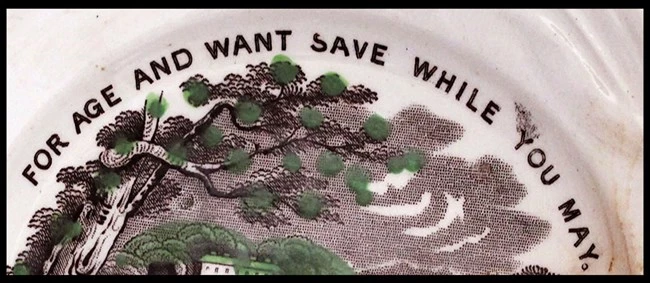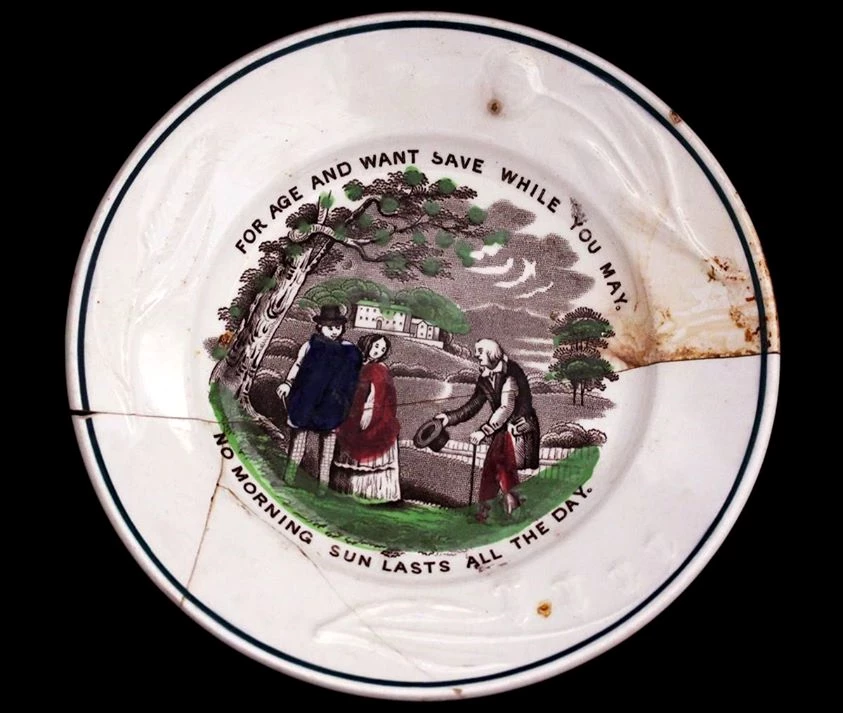Part of a series of articles titled Curious Collections of Fort Stanwix, The 19th & 20th Centuries.
Previous: Gothic Pickle Bottle
Next: Imported Ink Bottle
Article

The Industrial Revolution of the 18th century created new economic opportunities, eventually leading to the growth of the middle class. During the Victorian era (1837-1901), western society believed that hard work and virtuous behavior were all it took for men to become successful and wealthy. In 1859, Samuel Smiles published his book Self Help, coining the term we still use today (Hughes 2014:2). Savings accounts began to appear in the United States in the 1830s, and this new form of banking encouraged consumers to accumulate wealth in the form of currency rather than property or possessions (“19th-Century Banking” n.d.: par. 5). After the Erie Canal broke ground in 1817, the cost of shipping goods dropped significantly, bringing more commodities to the state for middle class New Yorkers to purchase.
This ironstone plate captures the Victorian emphasis on thrift and saving. The center of the plate depicts a couple walking amid rolling hills with a large country home in the background. A beggar approaches them with hat outstretched, and they watch him warily. The plate’s design illustrates advice from Benjamin Franklin: “For age and want save while you may. No morning sun lasts all the day.”
The proverb on this plate first appeared in Benjamin Franklin’s popular Poor Richard’s Almanack. Copyright laws were already in existence in the 19th century, and this saying would have been protected as Franklin’s intellectual property. However, copyright laws were often ignored, and many factories produced unauthorized plates and mugs that featured Franklin’s proverbs (Moonan 1998:2).
These objects were designed for children and were given as gifts for good behavior or reminders for mischief-makers. In both cases, the gifts were meant to teach a lesson, and often displayed the alphabet along their rims to boost their educational value (Moonan 1998:2). The rim of this plate depicts flowers and a sheaf of wheat, possibly meant to symbolize abundance and reinforce the featured proverb’s message.
Archeologists found the pieces of this ironstone plate in a 19th century privy during the reconstruction of Fort Stanwix (Hanson & Ping Hsu 1975:167). An area of reddish-brown staining on one of the pieces, or sherds, of the plate is the result of its time underground. The plate was likely manufactured between 1813, when ironstone was patented, and 1870, when running water arrived in downtown Rome and the majority of privies in the area were closed (Hume 1969:131; Outhouses 1974:30). This privy was lined with stone, possibly suggesting that it belonged to a relatively well-to-do household (Field Notes 1974:150; Outhouses 1974:33).

NPS Photo
“19th-Century Banking.” Old Sturbridge Village, n.d. Retrieved 24 August 2017 from https://www.osv.org/19th-century-banking
Associated Press. “Collectibles: Dishing Up History on Alphabet Pottery.” Los Angeles Times, 12 Nov. 1994. Retrieved from http://articles.latimes.com/1994-11-12/home/hm-61683_1_alphabet-pottery
Franklin, Benjamin. Wit and Wisdom From Poor Richard’s Almanack. Edited by Steve Martin. Random House, 2000.
Hanson, Lee. “Outhouses in Rome, New York.” Northeast Historical Archaeology, Vo. 3, No. 1, Spring 1974, pp. 30-43.
Hanson, Lee. “September 11, 1974 - Wednesday”. 1974. TS. Lee Hanson’s Field Notes, Fort Stanwix Archaeological Project, 1970-1978, pg. 150. Fort Stanwix National Monument, Rome, NY.
Hanson, Lee and Ping Hsu, Dick. Casemates and Cannonballs: Archeological Investigations at Fort Stanwix National Monument. Publications in Archeology, No. 14. Department of the Interior: Washington, D.C, 1975.
Hughes, Kathryn. The middle classes: etiquette and upward mobility. British Library, 15 May 2014. Retrieved from https://www.bl.uk/romantics-and-victorians/articles/the-middle-classes-etiquette-and-upward-mobility
Hume, Ivor Noël. A Guide to Artifacts of Colonial America. Knopf, 1969.
Moonan, Wendy. “Antiques; Presents for Children, Good and Bad.” New York Times, 17 July 1998. Retrieved from http://www.nytimes.com/1998/07/17/arts/antiques-presents-for-children-good-and-bad.html
Riley, Noël. Gifts for Good Children: The History of Children’s China, Part 1 1790-1890. Richard Dennis: Somerset, 1991.
Part of a series of articles titled Curious Collections of Fort Stanwix, The 19th & 20th Centuries.
Previous: Gothic Pickle Bottle
Next: Imported Ink Bottle
Last updated: October 6, 2022